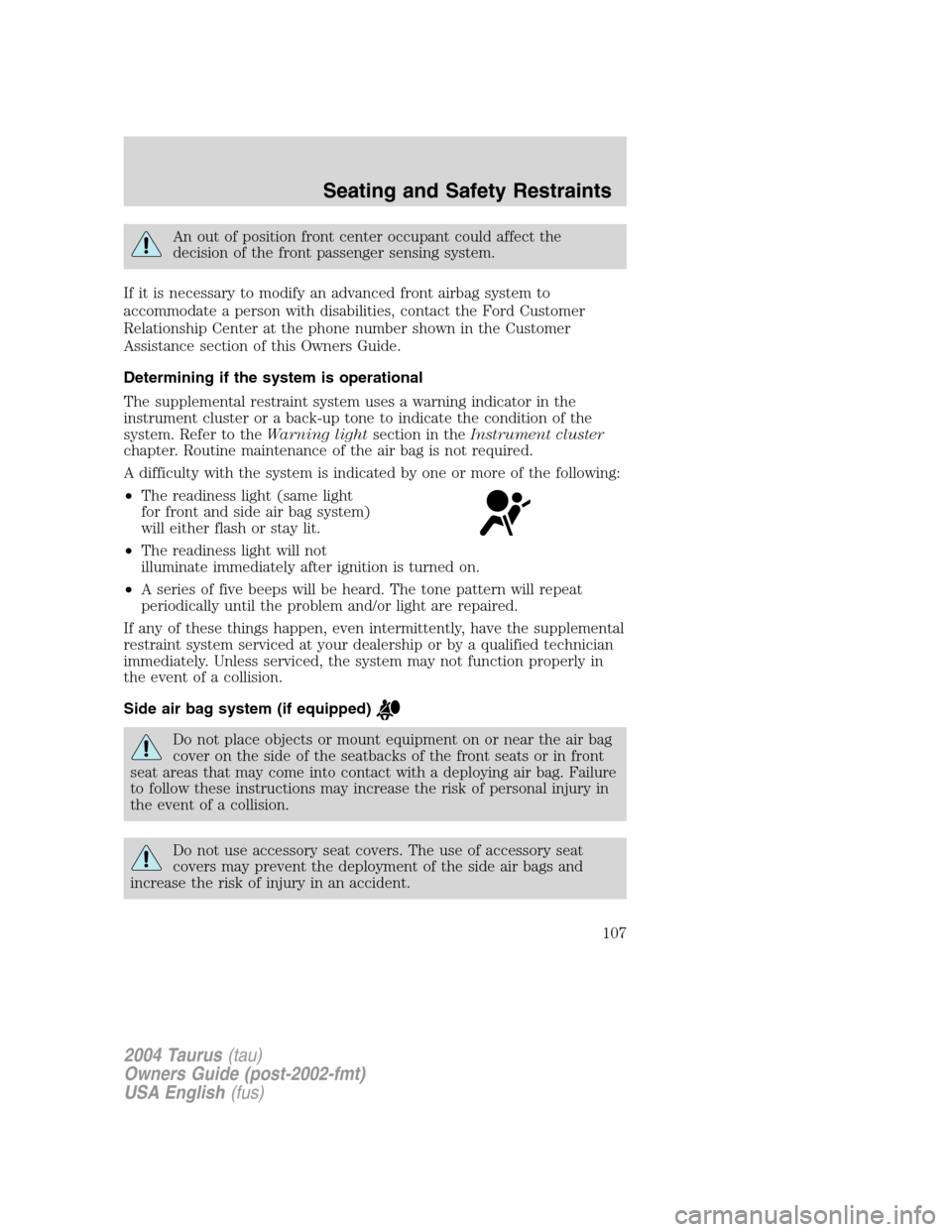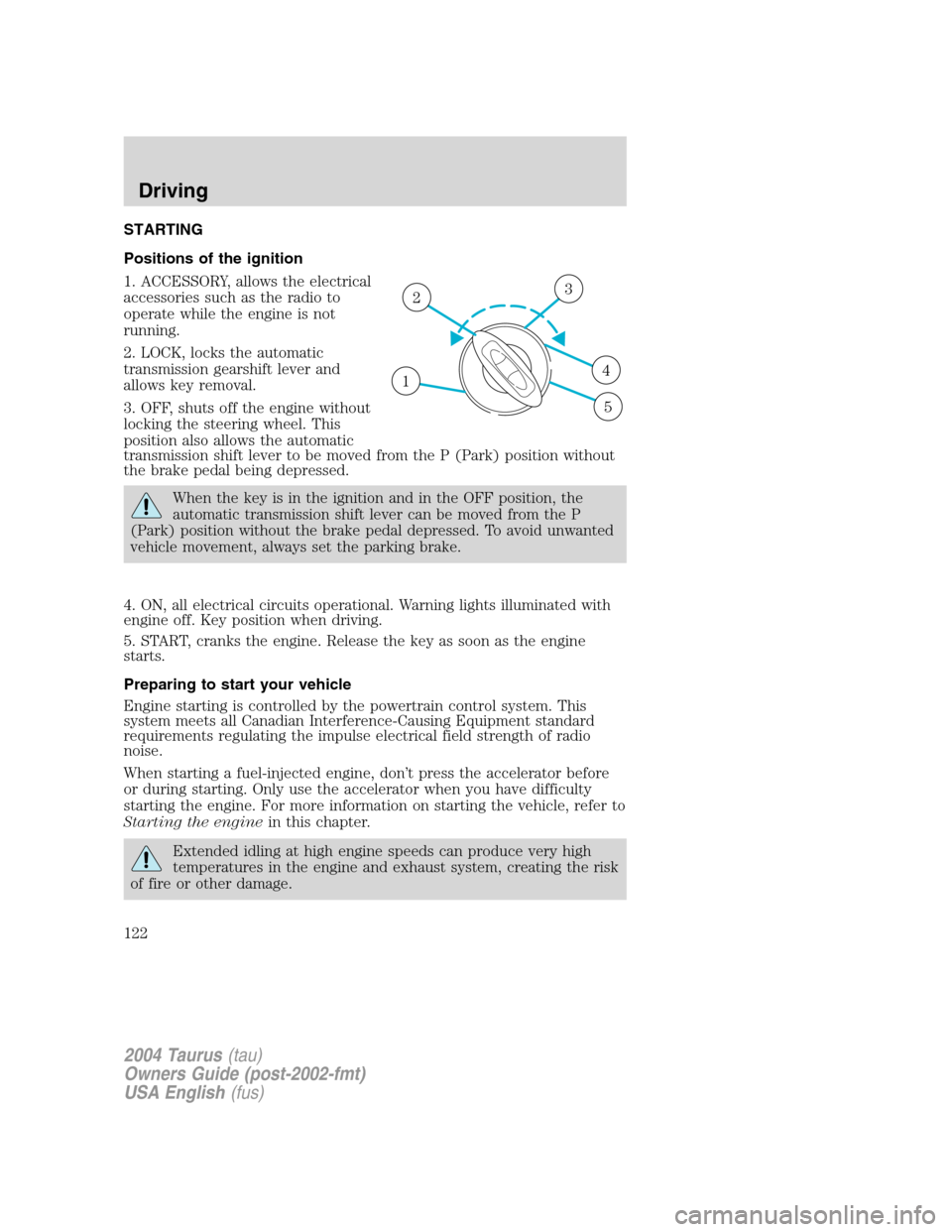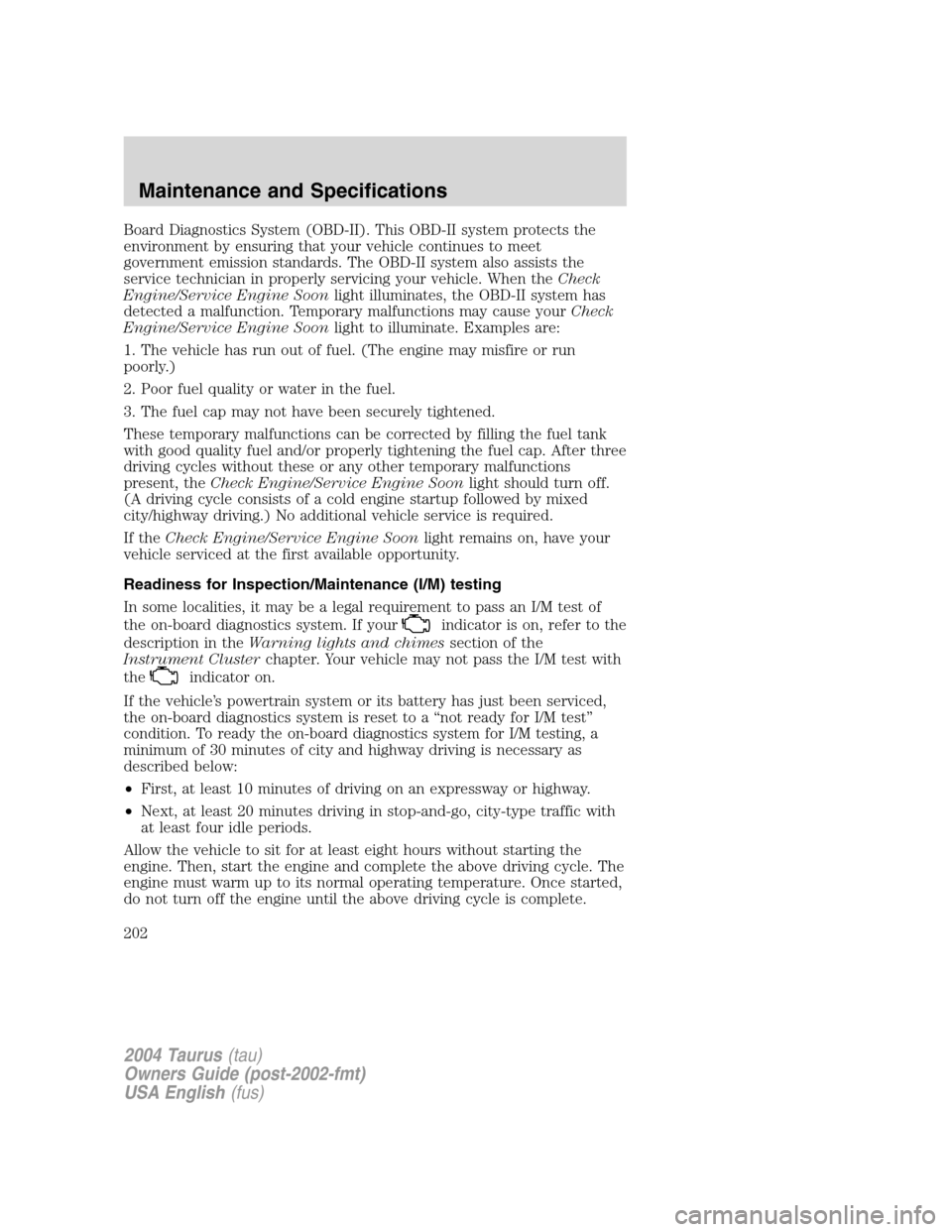2004 FORD TAURUS lights
[x] Cancel search: lightsPage 107 of 240

An out of position front center occupant could affect the
decision of the front passenger sensing system.
If it is necessary to modify an advanced front airbag system to
accommodate a person with disabilities, contact the Ford Customer
Relationship Center at the phone number shown in the Customer
Assistance section of this Owners Guide.
Determining if the system is operational
The supplemental restraint system uses a warning indicator in the
instrument cluster or a back-up tone to indicate the condition of the
system. Refer to theWarning lightsection in theInstrument cluster
chapter. Routine maintenance of the air bag is not required.
A difficulty with the system is indicated by one or more of the following:
•The readiness light (same light
for front and side air bag system)
will either flash or stay lit.
•The readiness light will not
illuminate immediately after ignition is turned on.
•A series of five beeps will be heard. The tone pattern will repeat
periodically until the problem and/or light are repaired.
If any of these things happen, even intermittently, have the supplemental
restraint system serviced at your dealership or by a qualified technician
immediately. Unless serviced, the system may not function properly in
the event of a collision.
Side air bag system (if equipped)
Do not place objects or mount equipment on or near the air bag
cover on the side of the seatbacks of the front seats or in front
seat areas that may come into contact with a deploying air bag. Failure
to follow these instructions may increase the risk of personal injury in
the event of a collision.
Do not use accessory seat covers. The use of accessory seat
covers may prevent the deployment of the side air bags and
increase the risk of injury in an accident.
2004 Taurus(tau)
Owners Guide (post-2002-fmt)
USA English(fus)
Seating and Safety Restraints
107
Page 122 of 240

STARTING
Positions of the ignition
1. ACCESSORY, allows the electrical
accessories such as the radio to
operate while the engine is not
running.
2. LOCK, locks the automatic
transmission gearshift lever and
allows key removal.
3. OFF, shuts off the engine without
locking the steering wheel. This
position also allows the automatic
transmission shift lever to be moved from the P (Park) position without
the brake pedal being depressed.
When the key is in the ignition and in the OFF position, the
automatic transmission shift lever can be moved from the P
(Park) position without the brake pedal depressed. To avoid unwanted
vehicle movement, always set the parking brake.
4. ON, all electrical circuits operational. Warning lights illuminated with
engine off. Key position when driving.
5. START, cranks the engine. Release the key as soon as the engine
starts.
Preparing to start your vehicle
Engine starting is controlled by the powertrain control system. This
system meets all Canadian Interference-Causing Equipment standard
requirements regulating the impulse electrical field strength of radio
noise.
When starting a fuel-injected engine, don’t press the accelerator before
or during starting. Only use the accelerator when you have difficulty
starting the engine. For more information on starting the vehicle, refer to
Starting the enginein this chapter.
Extended idling at high engine speeds can produce very high
temperatures in the engine and exhaust system, creating the risk
of fire or other damage.
1
23
4
5
2004 Taurus(tau)
Owners Guide (post-2002-fmt)
USA English(fus)
Driving
Driving
122
Page 124 of 240

•Make sure the parking brake is
set.
•Make sure the gearshift is in P
(Park).
•Turn the key to 4 (ON) without
turning the key to 5 (START).
Make sure the corresponding lights illuminate or illuminate briefly. If a
light fails to illuminate, have the vehicle serviced.
PRNDD1
1
23
4
5
2004 Taurus(tau)
Owners Guide (post-2002-fmt)
USA English(fus)
Driving
124
Page 139 of 240

Preparing to tow
Use the proper equipment for towing a trailer and make sure it is
properly attached to your vehicle. See your dealer or a reliable trailer
dealer if you require assistance.
Hitches
Do not use hitches that clamp onto the vehicle bumper. Use a load
carrying hitch. You must distribute the load in your trailer so that
10–15% of the total weight of the trailer is on the tongue.
Safety chains
Always connect the trailer’s safety chains to the frame or hook retainers
of the vehicle hitch. To connect the trailer’s safety chains, cross the
chains under the trailer tongue and allow slack for turning corners.
If you use a rental trailer, follow the instructions that the rental agency
gives to you.
Do not attach safety chains to the bumper.
Trailer brakes
Electric brakes and manual, automatic or surge-type trailer brakes are
safe if installed properly and adjusted to the manufacturer’s
specifications. The trailer brakes must meet local and Federal
regulations.
Do not connect a trailer’s hydraulic brake system directly to your
vehicle’s brake system. Your vehicle may not have enough
braking power and your chances of having a collision greatly increase.
The braking system of the tow vehicle is rated for operation at the
GVWR not GCWR.
Trailer lamps
Trailer lamps are required on most towed vehicles. Make sure all running
lights, brake lights, turn signals and hazard lights are working. See your
dealer or trailer rental agency for proper instructions and equipment for
hooking up trailer lamps.
Driving while you tow
When towing a trailer:
•Turn off the speed control. The speed control may shut off
automatically when you are towing on long, steep grades.
2004 Taurus(tau)
Owners Guide (post-2002-fmt)
USA English(fus)
Driving
139
Page 202 of 240

Board Diagnostics System (OBD-II). This OBD-II system protects the
environment by ensuring that your vehicle continues to meet
government emission standards. The OBD-II system also assists the
service technician in properly servicing your vehicle. When theCheck
Engine/Service Engine Soonlight illuminates, the OBD-II system has
detected a malfunction. Temporary malfunctions may cause yourCheck
Engine/Service Engine Soonlight to illuminate. Examples are:
1. The vehicle has run out of fuel. (The engine may misfire or run
poorly.)
2. Poor fuel quality or water in the fuel.
3. The fuel cap may not have been securely tightened.
These temporary malfunctions can be corrected by filling the fuel tank
with good quality fuel and/or properly tightening the fuel cap. After three
driving cycles without these or any other temporary malfunctions
present, theCheck Engine/Service Engine Soonlight should turn off.
(A driving cycle consists of a cold engine startup followed by mixed
city/highway driving.) No additional vehicle service is required.
If theCheck Engine/Service Engine Soonlight remains on, have your
vehicle serviced at the first available opportunity.
Readiness for Inspection/Maintenance (I/M) testing
In some localities, it may be a legal requirement to pass an I/M test of
the on-board diagnostics system. If your
indicator is on, refer to the
description in theWarning lights and chimessection of the
Instrument Clusterchapter. Your vehicle may not pass the I/M test with
the
indicator on.
If the vehicle’s powertrain system or its battery has just been serviced,
the on-board diagnostics system is reset to a“not ready for I/M test”
condition. To ready the on-board diagnostics system for I/M testing, a
minimum of 30 minutes of city and highway driving is necessary as
described below:
•First, at least 10 minutes of driving on an expressway or highway.
•Next, at least 20 minutes driving in stop-and-go, city-type traffic with
at least four idle periods.
Allow the vehicle to sit for at least eight hours without starting the
engine. Then, start the engine and complete the above driving cycle. The
engine must warm up to its normal operating temperature. Once started,
do not turn off the engine until the above driving cycle is complete.
2004 Taurus(tau)
Owners Guide (post-2002-fmt)
USA English(fus)
Maintenance and Specifications
202
Page 230 of 240

FORD ACCESSORIES FOR YOUR VEHICLE
A wide selection of genuine Ford accessories are available for your
vehicle through your local authorized Ford or Ford of Canada dealer.
These quality accessories have been specifically engineered to fulfill your
automotive needs; they are custom designed to complement the style
and aerodynamic appearance of your vehicle. In addition, each accessory
is made from high quality materials and meets or exceeds Ford’s rigorous
engineering and safety specifications. Ford Motor Company will repair or
replace any properly dealer-installed Ford accessory found to be
defective in factory-supplied materials or workmanship during the
warranty period, as well as any component damaged by the defective
accessory. The accessory will be warranted for whichever provides you
the greatest benefit:
•12 months or 20,000 km (12,000 miles) (whichever occurs first), or
•the remainder of your new vehicle limited warranty.
This means that genuine Ford accessories purchased along with your
new vehicle and installed by the dealer are covered for the full length of
your New Vehicle’s Limited Warranty—3 years or 60,000 km (36,000
miles) (whichever occurs first). Contact your dealer for details and a
copy of the warranty.
Not all accessories are available for all models.
Following is a list of several Ford Genuine Accessory products. Not all
accessories are available for all models. To find out what accessories are
available for your vehicle, please contact your dealer or visit our online
store at: www.fordaccessoriesstore.com.
Exterior style
Bug shields
Deflectors
Exterior trim kits
Front end covers
Grille inserts
Headlamps, fog lights and Daytime Running Lamps (DRLS)
Splash guards
Wheels
Interior style
Cell phone holders
Electrochromatic compass/temperature interior mirrors
2004 Taurus(tau)
Owners Guide (post-2002-fmt)
USA English(fus)
Accessories
Accessories
230
Page 234 of 240

Engine oil ..................................182
checking and adding ..............182
dipstick ....................................182
filter, specifications ........184, 220
recommendations ...................184
refill capacities ........................221
specifications ..................222, 224
Exhaust fumes ..........................126
F
Flexible Fuel Vehicle (FFV) ....191
Floor mats ...................................63
Fluid capacities .........................221
Fuel ............................................191
calculating fuel
economy ............................55, 197
cap ...........................................194
capacity ...................................221
choosing the right fuel ...........195
comparisons with EPA fuel
economy estimates .................200
detergent in fuel .....................197
filling your vehicle with
fuel ...........................191, 194, 197
filter, specifications ........197, 220
fuel pump shut-off switch .....143
improving fuel economy ........197
octane rating ...................195, 224
quality ......................................196
running out of fuel .................197
safety information relating to
automotive fuels .....................191
Fuel - flex fuel vehicle
(FFV) .................................191, 195
Fuses ..................................145–146
G
Gas cap (see Fuel cap) ............194Gas mileage
(see Fuel economy) .................197
Gauges .........................................13
H
Hazard flashers .........................143
Headlamps ...................................29
aiming ........................................30
autolamp system .......................29
bulb specifications ....................34
daytime running lights .............29
flash to pass ..............................30
high beam .................................30
replacing bulbs .........................35
turning on and off ....................29
Heating
heating and air conditioning
system .................................24–25
Hood ..........................................178
I
Ignition ...............................122, 224
Infant seats
(see Safety seats) .....................113
Inspection/maintenance (I/M)
testing ........................................202
Instrument panel
cleaning ...................................174
cluster ........................................10
lighting up panel and
interior .......................................30
J
Jack ............................................151
positioning ...............................151
storage .....................................151
Jump-starting your vehicle ......156
2004 Taurus(tau)
Owners Guide (post-2002-fmt)
USA English(fus)
Index
234
Page 235 of 240

K
Keyless entry system .................74
Keys
positions of the ignition .........122
L
Lamps
autolamp system .......................29
bulb replacement
specifications chart ..................34
daytime running light ...............29
headlamps .................................29
headlamps, flash to pass ..........30
instrument panel, dimming .....30
interior lamps .....................32–34
replacing
bulbs ..................33, 35, 37–40, 42
Lane change indicator
(see Turn signal) ........................32
Liftgate ........................................63
Lights, warning and indicator ....10
anti-lock brakes (ABS) ..........127
Load limits .................................134
Locks
childproof ..................................68
doors ..........................................67
Lubricant specifications ...222, 224
Lumbar support, seats ...............82
M
Message center .....................53–54
english/metric button ...............58
system check button ................59
warning messages .....................59
Mirrors ...................................46–47automatic dimming rearview
mirror ........................................47
heated ........................................48
side view mirrors (power) .......48
Moon roof ....................................52
Motorcraft parts ................197, 220
O
Octane rating ............................195
Oil (see Engine oil) ..................182
Overdrive ...................................131
P
Parking brake ............................128
Parts (see Motorcraft parts) ....220
Passenger Occupant
Classification Sensor ...................86
Pedals (see Power adjustable
foot pedals) .................................49
Power adjustable foot pedals .....49
Power distribution box
(see Fuses) ...............................149
Power door locks ........................67
Power point .................................46
Power steering ..........................129
fluid, checking and adding ....203
fluid, refill capacity ................221
fluid, specifications .........222, 224
Power Windows ...........................47
R
Radio ................................15–16, 19
Rear window defroster ...............28
Relays ........................................151
2004 Taurus(tau)
Owners Guide (post-2002-fmt)
USA English(fus)
Index
235